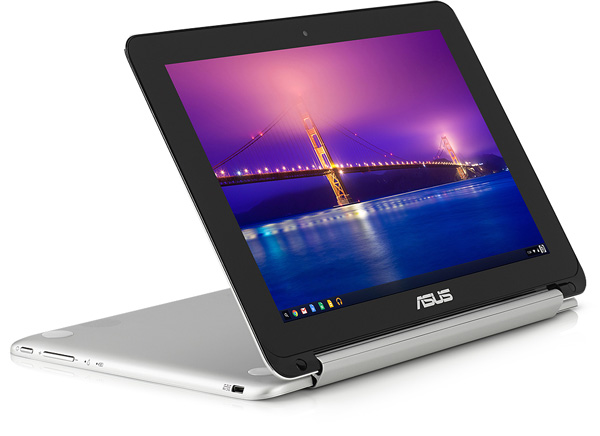Thoughts
Having a touchscreen on a $250 laptop curtails the potential of the underlying hardware, you would think. Asus gets around this by using an ARM-based Rockchip system-on-chip (SoC) known as RK3288-C. Operating at up to 1.8GHz the quad-core chip uses four Cortex-A17 cores alongside a quad-core ARM Mali T760 MP4 GPU. Understandably, the SoC has full hardware support for Google's VP8 video codec.
Yet this isn't just an off-the-shelf ARM design, according to Rockchip, as the company uses a number of power-saving techniques, such as DDR frequency scaling, to drop typical SoC load power to sub-3W per hour, or comfortably below other competing Chromebooks. This is why Asus feels comfortable in quoting a near-double-digit battery life from a fairly small battery.
The Flip isn't the only beneficiary of this particular SoC, mind, as Haier and HiSense use it in some of their Chromebooks too, but it appears that Google and Rockchip have optimised this particular silicon brew for inexpensive machines that pack a reasonable punch. Buffering operations is either 2GB or 4GB of low-power DDR3 memory.
In use
Chromebook Flip works best in standard laptop mode. Small and light enough to go unnoticed on your lap for extended periods, the combination of good keyboard and decent-enough display makes it better at browsing than a tablet alone. Perhaps the only downside is the muffling of audio from the downward-firing speakers.
Flipping it over to tablet orientation has the unwanted side-effect of having the keys resting on the bottom. The unit feels a tad weird in your lap, with the keys noticeable when pressing down on the screen. The Flip can't be all things to all people, particularly at the $250 starting price point, so, with due appreciation of the low-pixel-count screen, the tablet experience, whilst passable, is akin to a budget model's.
The solidity of the hinge provides a third way of viewing content on the Chromebook Flip. Pushing the screen backwards enough to have the keys at the bottom and the panel at, say, 60° provides a tent-like mode that's best for watching movies or online content without the need to invest in a custom stand.
What about that fanless Rockchip SoC's performance? It's smooth for everyday tasks such as browsing and video playback. Opening up five browser tabs does little to slow it down, and while it does get a little warm, there's never any cause for lag-related concern. Pushing it more with HD video calls on top of multiple browser tabs and music playing in the background - heavy-load use for a Chromebook - does little to dampen the experience.
The speed of the machine is never electric but neither is it slow, and like so much of modern technology, it's the slow that's noticeable. We'd certainly recommend opting for the 4GB RAM-equipped model, rather than the cheaper 2GB, because it buffers application performance nicely.
Impressive as the build quality and price are, the real boon of the Chromebook Flip is its seemingly indefatigable battery life. Pottering around the web whilst watching the occasional high-definition YouTube video and composing the odd email - regular Chromebook use, if you will - had negligible impact on battery life.
We lasted an entire weekend of regular activity, amounting to well over 10 hours' use, before battery life become an issue. In formal testing of looping a full-screen YouTube clip the Chromebook Flip managed over 10 hours, too, intimating excellent efficiency from the Rockchip SoC and screen.
Battery longevity is far more consistent with leading tablets than cheap-and-cheerful laptops, however, and we didn't feel the need to check on the battery life as commonly as we would on an entry-level laptop. Chromebooks have been popularised as all-day computing devices; the Flip certainly lives up to that mantle.
Wrap
The Asus Chromebook Flip is a thin, light, inexpensive and very well-built laptop that also functions as a tablet. More than acceptable performance is accompanied by all-day battery life, and while the Chrome OS-powered machine works best in laptop mode, the 10.1in touchscreen is reasonable for tablet duties.
As long as you're clear that the Flip isn't a replacement for a productivity laptop or premium tablet, yet is a slimmed-down proxy for each, there's little to take the shine off this $250 device. And if you don't want, or need, flip functionality then Asus has the space covered with the even cheaper, laptop-only C201.
We come away from a week's long play with the Chromebook Flip pleasantly surprised by how well it is able to cover the key requirements of anyone looking for an inexpensive hybrid device. The Rockchip SoC doesn't feel unduly underpowered when subject to heavy load, the keyboard and trackpad are decent, and the screen, while lacking resolution, is serviceable. Just make sure you opt for the 4GB model to avoid performance pitfalls.
Want a multipurpose laptop-cum-tablet that won't break the bank? The Asus Chromebook Flip might just surprise you.

The Good |
The Bad |
|
Good build quality Great value Solid performance from Rockchip SoC Useful in all modes |
Super-thick bezel |

Asus Chromebook Flip
HEXUS.where2buy
TBC.
HEXUS.right2reply
At HEXUS, we invite the companies whose products we test to comment on our articles. If any company representatives for the products reviewed choose to respond, we'll publish their commentary here verbatim.














